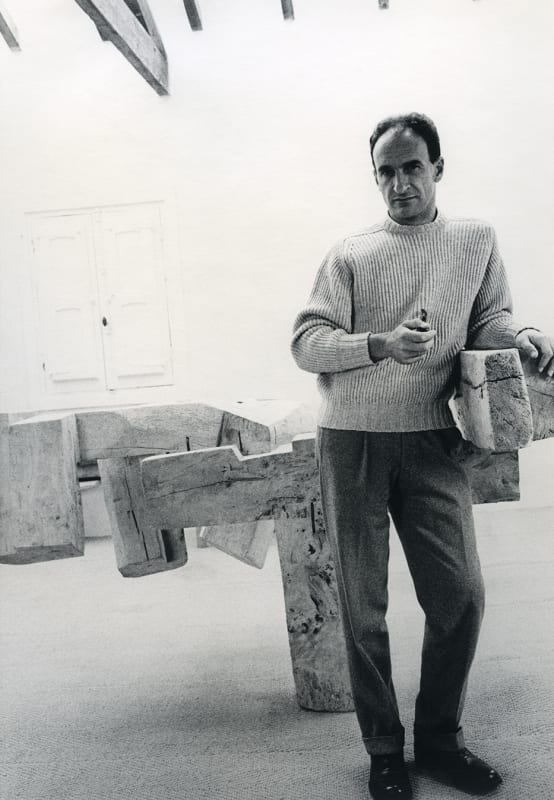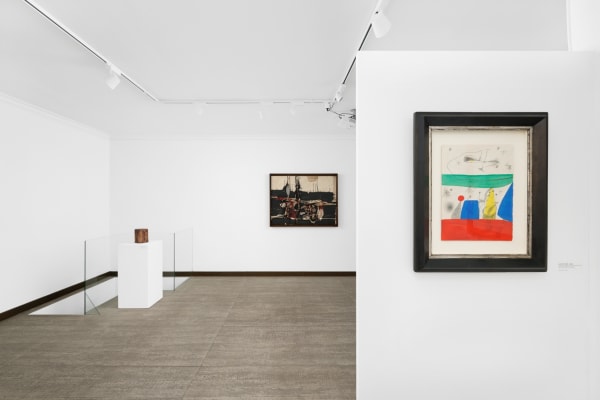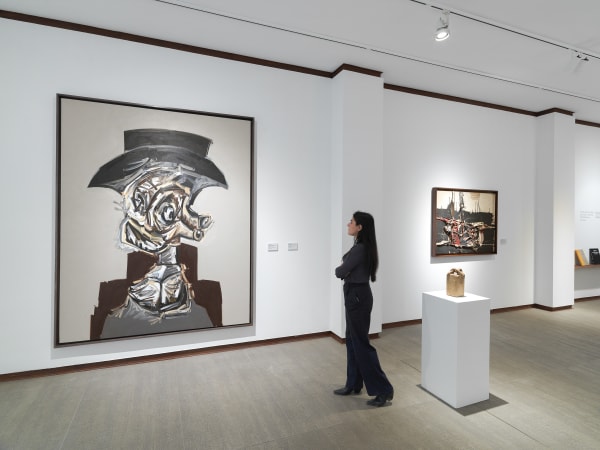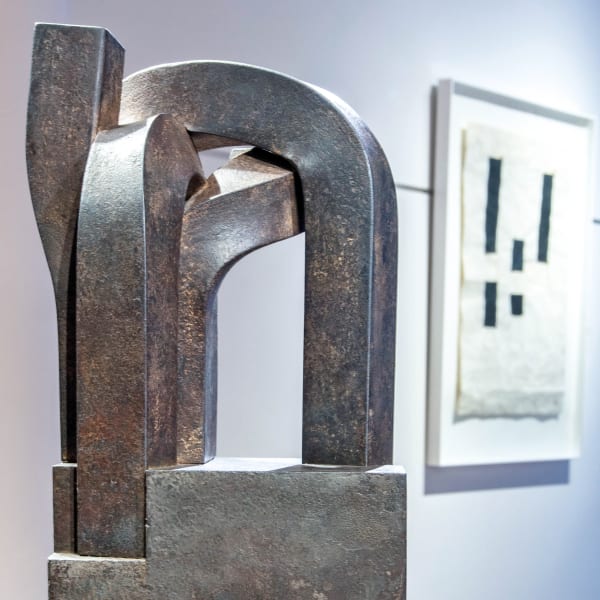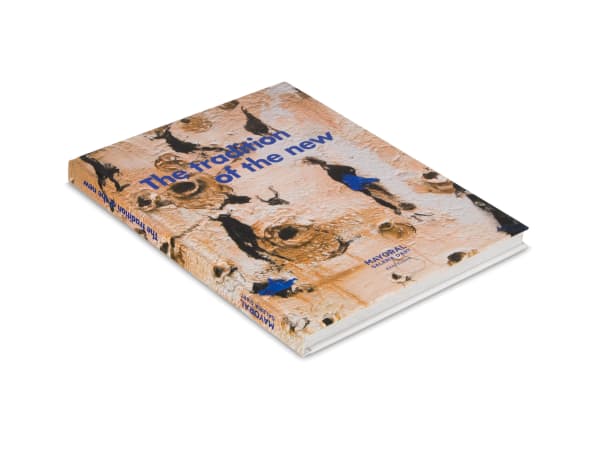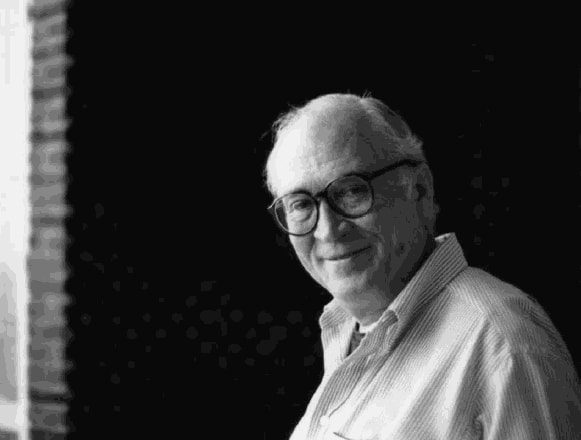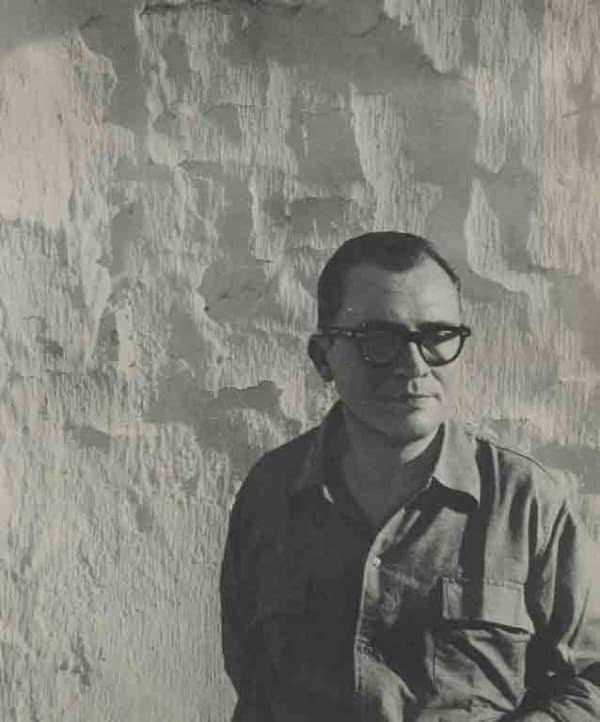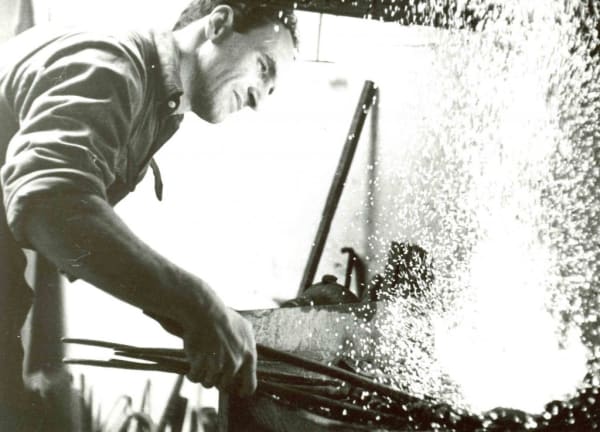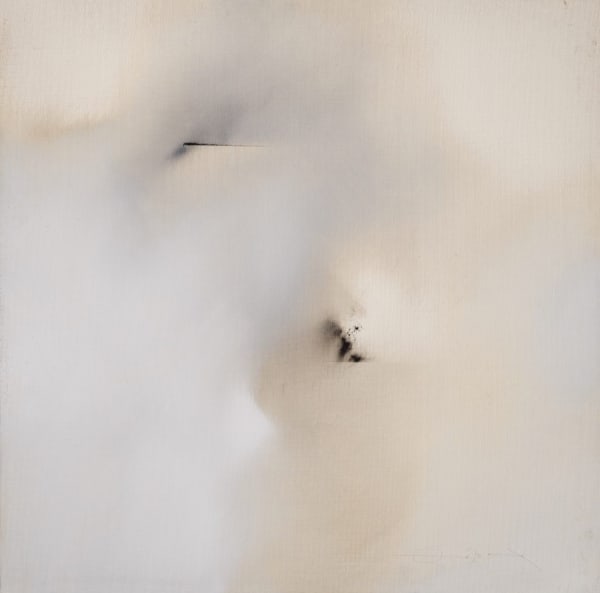Eduardo Chillida San Sebastián, 1924-2002
Overview
“ Space must be conceived in terms of plastic volume… Form springs spontaneously from the needs of the space that builds its dwelling like an animal its shell. Just like this animal I am also an architect of the void.”- Eduardo Chillida
Eduardo Chillida had a varied and pioneering practice that encompassed small-scale sculpture, plaster work, drawing, engraving, and collage. However, he is best known for his prominent monumental public sculptures displayed in Spain, Germany, France, and the USA. Chillida's work was deeply influenced by his Spanish heritage and a fascination for organic forms. Drawing inspiration from European and Eastern philosophies, poetry, and history, he developed an artistic voice that not only communicated his vision but also resonated with a continent undergoing rapid transformation. His exploration of space, form, and materiality brought a profound sense of harmony and connection, making him a highly influential figure in the art world and leaving a lasting impact on contemporary sculpture.
Works
Biography
Eduardo Chillida (San Sebastián, 1924-2002), initially pursued studies in architecture but abandoned that path in 1947 to dedicate himself to drawing and sculpture. While his early artistic endeavors involved stone, he soon embraced iron as the foundational material for his creations. Following his first major exhibition at Galerie Maeght in Paris in 1956, Chillida's work gained international recognition. The artist believed that the essence of sculpture and volume emerges from the inherent qualities of the materials themselves. His works, characterized by abstraction and minimalism, revolve around three central themes: space, emptiness, and boundaries. Chillida's sculptures demonstrate a remarkable economy of means, an imposing sense of monumentality, a profound harmony with the surrounding environment, and a commanding connection with space that possesses both an aura and a totemic quality. Scholars such as Octavio Paz and José Ángel Valente, as well as philosophers like Martin Heidegger and Émile Cioran, have extensively explored his sculptures and prints, as well as his public artworks. In 2000, the Museo Chillida-Leku opened in Hernani, Guipúzcoa, housing a notable collection of the artist's works.
Since the beginning of his artistic career in collaboration with Aimé Maeght in Paris, Chillida's artwork has been showcased in numerous museums and institutions worldwide. His international reputation soared in 1958 when he received the International Grand Prize for Sculpture at the Venice Biennale and the Graham Foundation Prize in Chicago. Chillida's sculptures can be found in over forty public installations across natural landscapes and cities like Barcelona, Berlin, Frankfurt, Paris, San Sebastian, and Washington, D.C., with a significant concentration in Germany, where the artist is highly esteemed.
His work has been featured in numerous retrospective exhibitions held at renowned institutions, including the Museum of Fine Arts in Houston (1966), the National Gallery in Washington, D.C. (1979), the Martin-Gropius-Bau in Berlin (1991), the Museo Nacional Centro de Arte Reina Sofía (MNCARS) in Madrid (1999), the Guggenheim Museum in Bilbao (1999), and the Galerie nationale du Jeu de Paume in Paris (2001). Chillida's sculptures are part of the collections housed in various museums across Germany (such as Manheim, Berlin, Frankfurt, Düsseldorf, Münster, among others), Switzerland (Basel, Zurich, Geneva, Winterthur, among others), and the United States (New York, Houston, Dallas, Chicago, among others).
Exhibitions
-

La radicalité à l'oeuvre
PARIS 6 Jun - 21 Aug 2023Mayoral is delighted to announce its summer group exhibition, showcasing a selection of works by post-war artists who, in their individual ways, embraced a radical approach in their creative processes:...Read more -

Saura in his context
BARCELONA 13 Apr - 30 Jun 2023This exhibition, organized in conjunction with Enrique Juncosa, presents six very characteristic works by Antonio Saura (1930-1998), one of the most important Spanish artists of the 20th century, in dialogue...Read more -

Zóbel and the Great Post-War Generation
MADRID 12 - 21 Mar 2021Mayoral’s first exhibition in Madrid, ‘Zóbel and The Great Post-War Generation’, will be held from the 11th to 21st March at the Fundación PONS. The exhibition brings together more than...Read more -

Zóbel-Chillida. Crisscrossing Paths
PARIS 12 Sep - 29 Oct 2020Mayoral presents the exhibition 'Zóbel-Chillida: Crisscrossing Paths' in their gallery in Paris. The exhibition will be a dialogue between two major post-war artists— Basque sculptor Eduardo Chillida (1924-2002) and Hispano-Philippine...Read more
-

Venezia 1958
BARCELONA 26 Sep - 4 Dec 2019The Galeria Mayoral revisits an exhibition held in the Spanish Pavilion at the 1958 Venice Biennale. This is the first time an exhibition reunites, more than 60 years after the...Read more -

Zóbel-Chillida. Croisscrossing Paths
BARCELONA 25 Apr - 25 Jul 2019Mayoral is pleased to present Zóbel-Chillida: Crisscrossing Paths, an unprecedented dialogue between Fernando Zóbel and Eduardo Chillida. Curated by Alfonso de la Torre and with the collaboration of the artists’...Read more -

Chillida. Despertar
BARCELONA 20 May - 27 Jun 2015Presented by Mayoral Galeria d'Art, the art exhibition 'Despertares' by artist Eduardo Chillida is currently on display until June 27, 2015. Remarkably, after 11 years, another exhibition showcasing Chillida's works...Read more
Publications
-
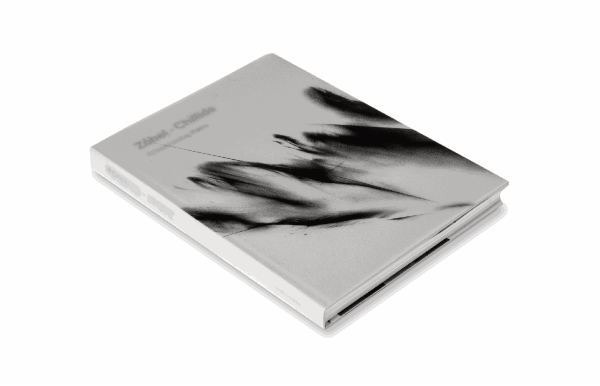
Zóbel-Chillida
Chemins Croisés 2019Hard Cover, 215 pagesRead more
Publisher: Mayoral Investigacio
Dimensions: 31 x 22.9 x 0.3 cm -

Venezia 1958
2019Hardcover, 198 pagesRead more
Publisher: Mayoral Investigació
Dimensions: 31,5 x 23,5 cm -
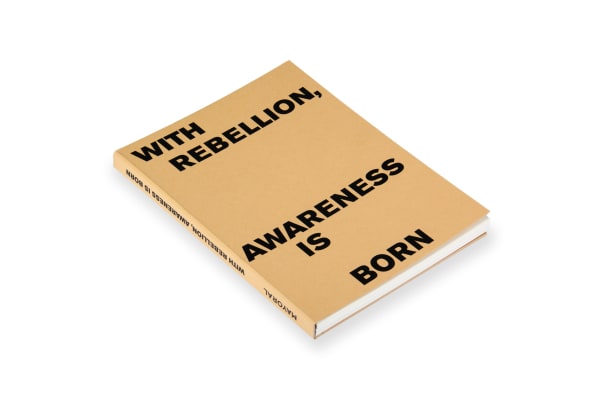
With rebellion awareness is born
2018Hardcover, 120 pagesRead more
Publisher: Mayoral Investigació
Dimensions: 23,5 x 17 cm -
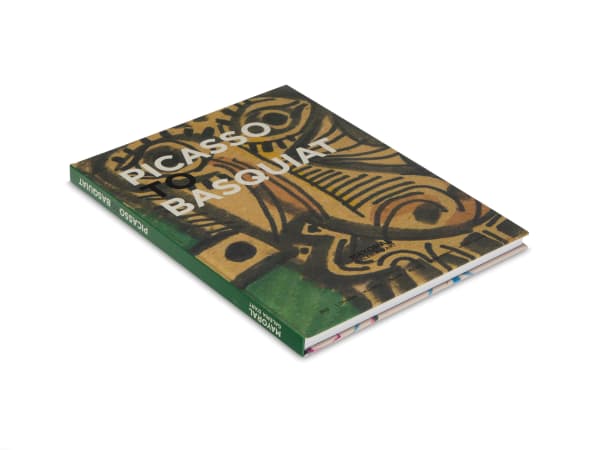
Picasso to Basquiat
2013Hardcover, 135 pagesRead more
Publisher: Mayoral Investigació
Dimensions: 31.7 x 24 cm
News
-

Talk by Alfonso de la Torre on “Zóbel-Chillida. Crisscrossing Paths” (French)
The curator of “Zóbel-Chillida. Crisscrossing Paths” talks about the exhibition organised at Galeria Mayoral, Barcelona-Paris September 19, 2020Talk by Alfonso de la Torre, curator of the exhibition “Zóbel-Chillida. Crisscrossing Paths”. 16 September, 2020 (French)Read more -

A Conversation between Wilfredo Prieto and Rosa Lleó
On the occasion of the exhibition "Venezia 1958" at Galeria Mayoral, Barcelona October 31, 2019Mangos, Limes and Flags In 1958, Spain, like Portugal, was an insular, extremely poor country with a strong presence of the military and of Opus...Read more -

A Conversation between Pere Portabella and Vicenç Altaió
On the occasion of the exhibition "Venezia 1958" at Galeria Mayoral, Barcelona October 30, 2019We found ourselves in the dark night of the Franco dictatorship dominated by Castilianity and the cross: National Catholicism. A new generation, which hadn’t fought...Read more -

Bearing Witness to the 1958 Venice Biennale | Luis González Robles
Luis González Robles, curator of the Spanish Pavilion, speaks about the 29th Venice Biennale October 11, 2019Spanish Artists in the 29th Venice Biennale International Art Exhibition Spanish Pavilion, 1958 For this 29th Venice Biennale a series of works by artists representative...Read more -

On the 1958 Venice Biennale, Still | María Dolores Jiménez-Blanco
María Dolores Jiménez-Blanco talks about the 1958 Venice Biennale October 5, 2019The Spanish Pavilion at the 29th Venice Biennale, the edition held in 1958, has become an inevitable landmark in narratives to do with Spanish art...Read more -

Letters from Fernando Zóbel to Eduardo Chillida
A collection of letters from Eduardo Zóbel to Eduardo Chillida dated between 1964-1979. Published in the exhibition catalogue "Zóbel-Chillida. Criscrossing paths" May 20, 2019Letter from Fernando Zóbel of 17 September 1964 in which he expresses his satisfaction with their meeting in Cuenca and gives more detail on the...Read more -

Memory of Qualities | Patrick D. Flores
Epilogue by Patrick D. Flores on the occasion of the exhibition "Zóbel-Chillida. Crisscrossing Paths" at Galeria Mayoral, Barcelona-Paris May 19, 2019When Fernando Zóbel turned to abstraction sometime in the fifties, he thought of his newfound form as being shaped by memory. When probed by the...Read more -

Words and ways about the Eulogy of the Horizon and other public sculptures (1990) | Fernando Huici
Fernando Huici interviews Eduardo Chillida. Published in the catalogue "Zóbel-Chillida. Criscrossing paths " on the occasion of the exhibition at Galeria Mayoral, Barcelona-Paris May 15, 2019FH [Fernando Huici]: In any case, from an immediate contemplation of your piece, the illusion is that of a very strict geometry. EC [Eduardo Chillida]:...Read more -

An interview with Ignacio Chillida Belzunce and Fernando Zóbel de Ayala y Miranda | Alfonso de la Torre
Alfonso de la Torre interviews Ignacio Chillida Belzunce, the son of Eduardo Chillida, and Fernando Zóbel de Ayala y Miranda. Text Published in the exhibition catalogue "Zóbel-Chillida. Criscrossing paths" May 14, 2019The image of the artist nowadays Alfonso de la Torre [AT]: When I consider certain artists who are no longer with us, hoping to know...Read more -

International Conference on Sculpture (August 1988) | Eduardo Chillida
Text of the lecture given by Eduardo Chillida at Trinity College, Dublin on the occasion of the International Conference on Sculpture on August 1998. Text Published in the exhibition catalogue "Zóbel-Chillida. Criscrossing paths " May 13, 2019Limits are the real protagonists of space, just as the present, another limit, is the real protagonist of time. The concept of place implies dimension...Read more -

Zóbel-Chillida, a Meeting | Alfonso de la Torre
Alfonso de la Torre, curator of the exhibition "Zóbel-Chillida. Criscrossing paths " at Galeria Mayoral Barcelona-Paris , talks about the connections of Zóbel and Chillida during his life April 29, 2019[Like crisscrossing paths, the lives of Zóbel and Chillida intersected in the mid-sixties. In the fifties, with the two of them a long way from...Read more





